Media | Articles
Inventing a New ICE in an EV Age: The Waissi Engine
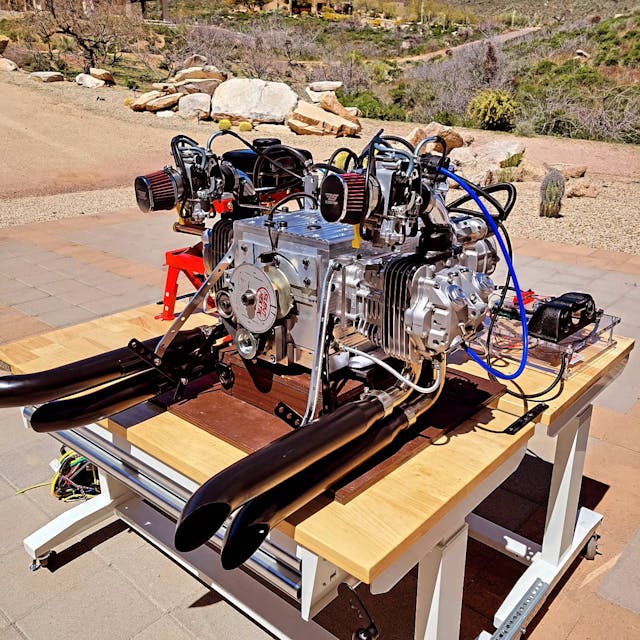
I admit to being a bit of a romantic when it comes to inventors, particularly independent ones who are pursuing their dreams without the resources of a large corporation, government agency, or university. There’s something special and quite human about seeing a connection that others don’t see and keeping at it. Clessie Cummins made more than 3000 prototypes while developing his fuel injector for diesel engines.
Sometimes the story ends up in failure and obscurity, other times in generational wealth and celebrity. More often than not, the success lies not in business or fame but rather in increasing human knowledge. Of course, sometimes you learn that something simply doesn’t work. For most inventors, that’s not a reason to give up but rather to consider alternative solutions. Like Thomas Edison said, “I have not failed. I’ve just found 10,000 ways that won’t work.”
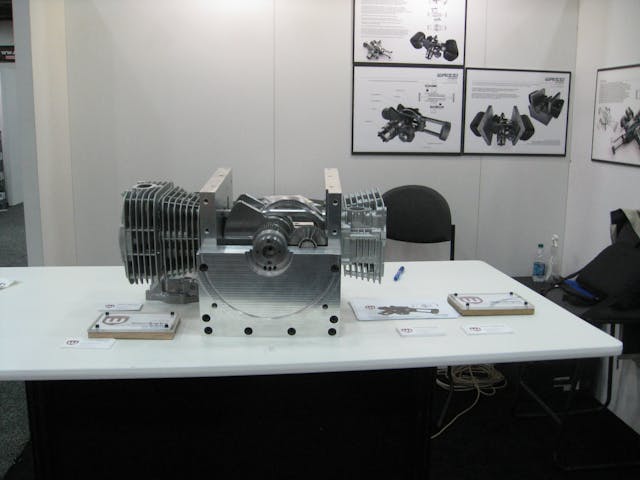
About 50 years ago, engineering professor Gary Waissi was teaching a course in physics, and during his lecture he doodled a sketch of a disc mounted eccentrically on a shaft and realized that a piston could push directly on the edge of that disc, converting linear motion to rotational motion. Eliminating connecting rods and much of the crankshaft would have advantages in terms of reducing friction and weight in reciprocating-piston combustion engines, possibly making an engine based on the concept more efficient than conventional designs.
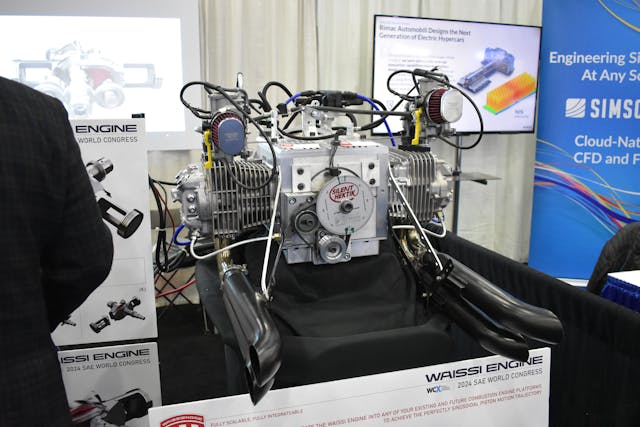
In the mid 1990s, then at Arizona State University, Waissi started working in earnest on the engine concept, based on a horizontally opposed two-cylinder design. The two pistons are linked together and move in tandem as they push on the disc and it rotates. Compared to a conventional engine, where forces from the connecting rod tilt the piston at an angle to the cylinder walls and create friction, the ganged pistons travel perfectly parallel to the cylinders. Later refinements put a circular ring around the “crankdisc,” upon which the pistons acted and within which the crankdisc spun. Additional development determined that flattening the sides of the annular ring that are in contact with the pistons further reduced friction.
You can read Waissi’s technical description at bottom.*
Marketplace
Buy and sell classics with confidence
To be honest, it’s easier to understand it with drawings and animations, but the bottom line is that it’s a very elegant idea.
Ten years ago, Waissi came to the Society of Automotive Engineers World Congress, where he displayed drawings, animations, and some engine parts, but the engine had not yet run outside of the digital domain. Since then, he’s built two running versions of the engine, with the current motor, which Waissi describes as “Version 1.9999 repeating,” being the sixth-generation design. That engine is now on display at this year’s SAE convention, and I got a chance to discuss the project’s progress and trajectory with the professor.

The concept will work with both spark (gasoline) and compression (diesel) ignition. I didn’t ask but I’m guessing it will work with Atkinson as well as Otto cycles.
The project has been pretty much self-financed and now reaches into six figures. Waissi Engines is a two-man operation. Gary Waissi is now retired from teaching and devotes much of his time to the project, with son Robert, also an engineer (who works in audio by day), helping. Gary says that the annual outlay has been between $10,000 and $20,000 a year, depending on what components they need to have made.
Anyone who has owned a Honda motorcycle or a car with an air-cooled OHC engine will recognize the cylinder barrels and heads on the prototype. As a matter of fact, that’s what drew a Honda engineer to the Waissi booth, texting photos of the motor back to Hamamatsu. Engineers from Ford, General Motors, and a handful of Chinese automakers also expressed interest. The overhead valves are operated via chains driven by auxiliary shafts geared to the main shaft. The animation above also shows some counter-rotating weights, also on auxiliary shafts, which Waissi said were intended to prevent rocking of the engine but in practice were found to be unnecessary.
As shown by the use of production Honda components, the Waissi engine is compatible with current automotive industry manufacturing and assembly methods. There are no exotic materials used, and all components unique to the engine can be made with conventional manufacturing processes.
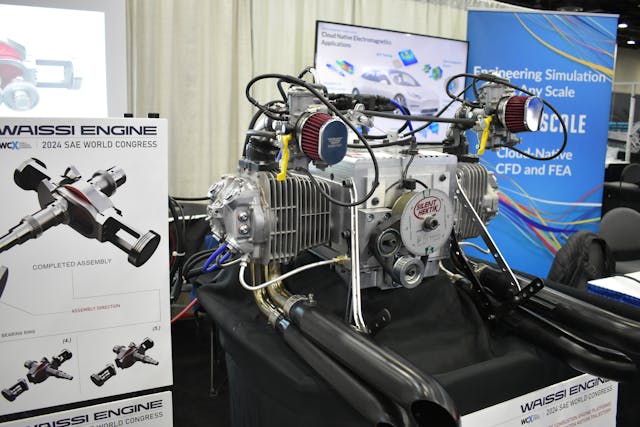
Waissi says there have been “nibbles” from major manufacturers. Beyond its applicability as a primary powertrain component, because of its compact size and light weight, the Waissi engine could see duty as a range extender in a hybrid system.
Personally, I think he needs to put it in the back of a vintage VW Beetle as a publicity stunt. Waissi has given some thought to possibly powering a VW-based dune buggy with the opposed-piston “V-180 degree” twin. With just 677 cc of displacement, the 175-pound engine is calculated to put out about 80 horsepower, though that figure remains to be tested on a dyno. Eighty horsepower out of less than 700 cc displacement is impressive in terms of specific output. What I found even more impressive is the fact that the engine can run at 10,000 rpm or higher.


While the Waissis have not yet run emissions or fuel-efficiency tests, it’s still a piston-based, overhead-valve engine with a more or less conventional combustion chamber, so unlike thirsty and relatively dirty Wankels, it should be as clean and at least as fuel efficient as conventional piston motors. Even if those specifications are only equivalent to conventional engines, it would be cheaper to build, as it has fewer parts to assemble.
Since the most powerful engine that VW put in the Type I weighed 244 pounds and put out just 60 hp, a Waissi-powered Bug or dune buggy should probably scoot pretty well. Actually, a production version of the Waissi engine would likely weigh even less than 175 pounds, as the prototype crankcase is milled from a big rectangular billet of aluminum, with no attempt made to reduce the finished weight.

The Waissi engine isn’t the only new take on piston-driven combustion engines to have been displayed at the SAE World Congress in recent years. Nautilus Engineering showed a novel compression-ignition engine with multiple combustion chambers, intended to improve the emissions performance of lawn equipment, but the company appears to be defunct, and the domain name for the company website is for sale.
When Gary Waissi had his minimalist booth at the 2014 SAE convention, Scuderi Engine had a large and expensive open-floor display with a cutaway example of its split-cycle engine inside a plexiglass case and another version mounted in a midsize sedan. Scuderi Engine was founded by the children of refrigerant compressor pioneer Carmelo Scuderi about 20 years ago to develop and license the engine that he patented. Scuderi Engine released a video of the engine running on a test bed in 2012, but the company has been mired in legal difficulties with the Securities and Exchange Commission, and with Toyota’s Hino division. As yet, the Scuderi engine has not come to production. The company still exists, apparently to manage a portfolio of hundreds of patents. A related company, Scuderi Clean Energy, rebranded as ESG Clean Energy, is ostensibly in the business of selling power generation while putting a lot of emphasis on the carbon capture market. The combination of the lawsuits, the emphasis on patent management and licensing, and buzzwords like “carbon capture,” coupled with ESG never publicly showing a running version of the engine (to the best of my knowledge and research), have made a few people skeptical about the Scuderi ventures.
Compared to Nautilus, which had a team of engineers and backing, and Scuderi, which worked hard at selling stock, cultivating investors, and putting on an impressive show, Waissi Engine is a modest venture. The LLC doesn’t even have a website. At 75, Gary Waissi doesn’t seem to be looking to make a fortune off of his idea, but rather to make a working engine and prove his concept. At this point, he seems to be succeeding. Perhaps there’s a lesson to be learned from that.
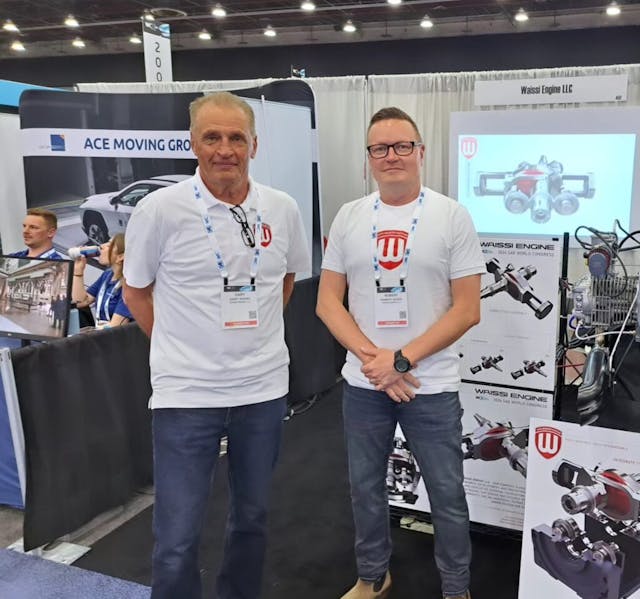
Asked why he’s devoting his time and not insignificant amounts of his own money to developing a new internal-combustion engine at a time when the industry, amid considerable government pressure, is moving quickly to battery-powered electrics, Gary Waissi said that ICEs will still be around for a long while.
“We have to consider the entire life cycle of an electric vehicle and its total environmental impact (from mining to electric grid to use to heavier impact on roads to replacement of batteries to disposal, etc). I think the future will not be one or the other, but some combination of technologies, and the internal-combustion engine will be in that mix. Also, alternative fuels and their research (including hydrogen, etc.) show great promise.”
Words of Waissi
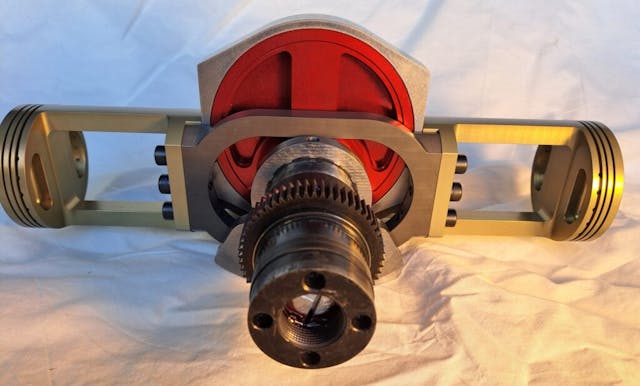
*GW: In the earlier version, we allowed the bearing ring (a perfectly circular ring) to slide under hydrodynamic conditions (oil pumped from inside the main shaft through channels inside the disk to under the bearing ring) on the top surface of the crankdisc. We noticed that allowing the bearing ring outer surface to slide/roll against the piston base created a higher-than-calculated (and expected) friction between the outer perimeter of the ring and the piston base. So we decided to change the outer perimeter ring shape to have a flat (or convex) surface against the piston base flat (or concave) surface and pump oil through the ring to that outer surface. This created a hydrodynamic condition between the outer part of the ring (non-rotating ring) and the piston base. This lowered the friction to the same level as friction inside the bearing ring against the crankdisc (to similar level and conditions as in the main journal(s) of a common crankshaft with cranks and piston rods). Theoretically, the inside surface of the bearing ring serves the same function as the big end of a piston rod; and, correspondingly, the outside surface of the bearing ring against the piston base serves the same function as the small end of the piston rod. The rigid piston structure does not allow the piston to tilt, and the piston side supports distribute the force against the cylinder walls over the combined length of the pistons, whereas in a regular combustion engine, the piston rod pushes the piston, in an angle, sideways against the cylinder wall. Our design significantly reduces all these main friction components.
***
Check out the Hagerty Media homepage so you don’t miss a single story, or better yet, bookmark it. To get our best stories delivered right to your inbox, subscribe to our newsletters.












ICE in a EV age.
Hmmm,
Even though it is air cooled, that appears to be an expedient way to get it prototyped and running. Any air cooled engine can be made more powerful and efficient with water cooling. If they get enough support, adding water jackets to the block, a radiator and using water cooled motorcycle cylinders will be trivial though expensive.
Motorcycle engine – that’s what immediately came to mind for me!
Old-style BMW?
Nice engine and concept. The hardest part is the initial working design. After the concept works – anything added after the fact is just an improvement to the original design. There are a lot of opinions of what should be done or how to improve it – but you did the initial work. Congratulations on our engine.
Lots of thoughtful comments here. I note that the use of conventional air-cooled barrels and heads with carburetors is just a place holder to prove the bottom end principles. Now, they need to test the engine under load to determine how long it lasts (MTBF). Then they can replace the barrels and heads with water-cooled versions using EFI, which could solve the sound and emissions issues.
Lot of metal going back and forth there on a cam. I believe camshafts work because they’re not pushing a lot of weight and they only work when the oil is good. My guess is the durability of this design is short lived. Interesting idea I admit.
Hi, I’d love to interview Gary Waissi on this brilliant idea for everyone to hear! Let me know, thanks.
An animated drawing of the basic components would go a long way in helping me understand how this engine actually works.
I believe that will come along when they get a web site up and running.
While I’m too dumb to understand all the intricacies, this sounds like a possible next generation ICE that might work.
I am not sure if this is or is not a great idea. It certainly is an idea that is neat to contemplate. For my money, I believe that IC engines will exist for a long, long time. The solution, given the warming hoax supporters, will be no carbon fuels. Somebody will figure a way to mix hydrogen with low, low carbon alcohol or whatever. The mix will become cheap, non polluting, easy to use and deliver. The EV excitement is waning. Nobody wants hybrid Mercedes AMG’s, access to electricity is limited, there is not enough anyway. EV cars are not the answer so IC will rule the roost.
It sounds good. Would be interesting to see in an old VW.
There is no legitimate, “EV Age”. It’s just a government funded power grab to gain more control of our lives. 75% of EV sales would disappear without government subsidies.
Here is another father/son engine inventor team in the same application arena. They have been at it some time and while not mass produced they seem to be able to attract investors including the US gov. So far I have passed on investing but some may find it promising.
https://invest.liquidpiston.com/#technology
Outwardly, looks very similar to the Citroën 2CV very simple, 2-cylinder air-cooled HEMI engine from the late 1930’s, but with about 3 or 4 times the HP. We have a Fourgonnette with the later 652 Citroën engine producing about 35 HP when new.
Some good comments. The friction issue bothered me, but they seem to have addressed it – maybe. If I understand the concept — in fact there is side loading, just not angular like a piston and rod. Today side wear on pistons and cylinders is negligible indicating minor friction losses in present day reciprocation engines. I look forward to seeing how this engine develops AND if it is cost competitive. Without support from a major manufacturer it is doubtful it will be more than a novelty. I remember all the hype around the Wankel rotary and only Mazda had the expertise and will to make it work well. GM tried, but every attempt to reduce manufacturing costs resulted in an inferior engine. One thing is for sure —- EV development and infrastructure support issues will result in the ICE/EV hybrid existing for sometime. I spent a year preparing for a new car and a hybrid meets my needs and those with them (some who owned a pure EV) had only positive comments. On the top of the list was excellent fuel economy, next was the freedom from charging issues.